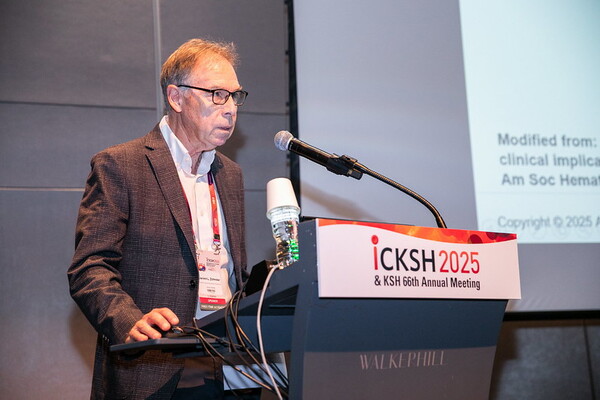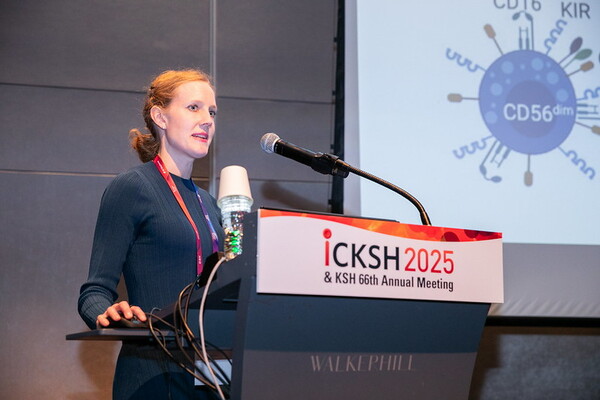At the "Cutting-Edge Diagnostic Techniques in Hematology" session of the International Congress of the Korean Society of Hematology (ICKSH) 2025, held on March 28 at the Grand Walkerhill Seoul, experts focused on how precision diagnostic technologies in hematologic malignancies are evolving.
The session covered techniques such as minimal residual disease (MRD) detection using next-generation sequencing (NGS), the latest CITE-seq technology that simultaneously analyzes RNA and proteins in immune cells, and attempts to determine whether specific ABL1 mutations confer resistance to tyrosine kinase inhibitors (TKIs) using prime editing.
These discussions also offered insights into the potential clinical applications of genome editing technologies.
Professor James L. Zehnder: NGS opens a new horizon in minimal residual disease analysis for hematologic malignancies

Professor James L. Zehnder of Stanford University School of Medicine delivered a presentation titled Minimal (measurable) disease in hematologic malignancy, highlighting MRD analysis in hematologic cancers using NGS.
MRD analysis is a powerful tool for accurately assessing treatment responses and predicting long-term prognosis in blood cancers. It helps interpret the clonal architecture of cancer, detect emerging clones, and customize treatment strategies for individual patients.
Recently, MRD analysis using NGS has attracted significant attention. Unlike conventional methods such as flow cytometry or digital droplet PCR (ddPCR), NGS can identify and track various genetic mutations simultaneously in a single test. This provides insights into genetic ontogeny, clonal architecture, and treatment response.
However, achieving this requires a multidisciplinary team including genomics and bioinformatics experts to suppress digital errors and apply statistical models to enhance assay sensitivity.
Some hospitals are currently using hybrid-capture-based NGS panels to assess MRD. A key challenge in this process is distinguishing between mutations that naturally occur in healthy individuals and those derived from residual disease. Variants in genes such as DNMT3A, TET2, and ASXL1 (known as DTA genes) often represent clonal hematopoiesis and are frequently excluded from MRD analyses.
Nonetheless, patients in whom such DTA mutations persist even during remission often belong to a high-risk group, highlighting the need for future research and separate risk classification.
Going forward, MRD analysis using NGS is expected to be interpreted in conjunction with cytogenetic testing, flow cytometry, and hematopathology results rather than being used as a standalone test.
Professor Jennifer A. Foltz: Mapping the immune cell landscape with CITE-seq: Identifying a new NK cell subset (eML)

Professor Jennifer A. Foltz of Washington University School of Medicine gave a lecture titled Exploring the transcriptional and protein landscape of immune cells with CITE-seq.
According to Professor Foltz, recent studies have increasingly shown that not only cancer cells themselves but also the identity and functional changes of surrounding immune cells significantly influence treatment responses and patient outcomes. In particular, natural killer (NK) cells and T cells form diverse subsets whose biological characteristics require single-cell level analysis for precise profiling.
To address this, CITE-seq (Cellular Indexing of Transcriptomes and Epitopes by Sequencing) has emerged as a cutting-edge technology. This method simultaneously analyzes RNA and protein data, enabling researchers to capture cell-cell interactions and subtle functional differences that flow cytometry or mass spectrometry might miss.
Her team focused on cytokine-induced memory-like (ML) NK cells, which play a crucial role in killing cancer cells, though their mechanisms remain incompletely understood. The researchers conducted CITE-seq analysis using 28 antibodies targeting NK cells across different maturation stages.
They discovered a previously unknown unique subset, naming it eML NK cells (extended Memory-Like NK cells). These cells were characterized as CD57-negative, NKG2A-positive, and CD39-positive, and they produced IFN-gamma in response to cytokines and tumor stimulation.
Interestingly, leukemia cells were found to stimulate and activate these eML NK cells. Among leukemia patients treated with ML NK cell therapy, two subpopulations—eML-1 and eML-2—were observed to persist long-term.
Professor Hyongbum Henry Kim: Using prime editing to precisely analyze ABL1 mutation resistance

If specific genetic mutations that confer drug resistance could be predicted in advance, more effective personalized treatment strategies could be developed.
A Korean research team recently succeeded in profiling the resistance of various ABL1 gene variants to TKIs using prime editing technology.
Professor Hyongbum Henry Kim of Yonsei University College of Medicine presented Comprehensive resistance profiling of ABL1 variants against various kinase inhibitors using prime editing, stating, "We used prime editing to predict whether ABL1 mutations confer resistance to TKIs, aiming to assist in selecting the most appropriate treatment drugs for individual patients."
Prime editing is an advanced gene-editing technology capable of precisely modifying single-nucleotide variations. However, its initial editing efficiency was only about 0.1 percent, posing challenges for practical applications.
To overcome this, the research team introduced DeepPRIME, a deep-learning-based predictive model, which successfully increased editing efficiency to between 30 and 50 percent.
They employed the PEER-seq (Prime Editing and Endogenous Region-sequencing) method to investigate resistance mutations in the EGFR gene's TKI-interaction domain, identifying mutations conferring resistance to osimertinib and afatinib.
This approach efficiently identified mutations that cause TKI resistance at the single-nucleotide variant (SNV) level.
Applying this method to chronic myeloid leukemia (CML) patients harboring the BCR-ABL1 fusion gene, the researchers confirmed that specific mutations generated via prime editing induced drug resistance in both cell lines and animal models.
The ability to predict drug resistance for individual genetic mutations is expected to be incorporated into future clinical practice guidelines and contribute to personalized patient care.
Related articles
- [ICKSH 2025] Basic principles of AI and its application in healthcare
- [ICKSH 2025] Molecular insights and targeted therapies take center stage in AML care
- [ICKSH 2025] CML care enters new era with next-gen sequencing: experts at ICKSH 2025
- [ICKSH 2025] CML therapy moves toward precision with asciminib and genomic profiling
- DKSH Healthcare Korea eyes growth as flexible and capable partner: GM
- [ICKSH 2025] CD38 at a crossroads of immune modulation and therapeutic innovation
- Ewha’s Ryu receives academic award from Korean hematology society
- [ICKSH 2025] Reimbursement policy determines success or failure of blood cancer treatment
- [ICKSH 2025] ‘High-risk pediatric AML needs precision, not more chemotherapy’
- [ICKSH 2025] ‘Advancing genetic insights to refine treatment strategies for Down syndrome-associated myeloid leukemia’
- [ICKSH 2025] ‘Ph-like ALL treatment paradigm shifting toward molecularly guided immuno- and targeted therapy’
- [ICKSH 2025] ‘Don't let treatment kill the patient before the disease does’: Mayo Clinic doctor
- [ICKSH 2025] CAR-T therapy reshapes lymphoma treatment amid new strategies and resistance challenges
- [ICKSH 2025] ‘Multiple myeloma patients must know about their disease. Our working party will help.’
- [ICKSH 2025] ICKSH expands beyond Asia, attracts experts from US and Europe
- [ICKSH 2025] Paroxysmal nocturnal hemoglobinuria drug Empaveli targets extravasation hemolysis
- [ICKSH 2025] Korean hematologists urge faster reimbursement for lifesaving blood cancer drugs
- New therapies push childhood leukemia cure rates to 90%
- [Column] New targeted therapies expand treatment options for acute myeloid leukemia patients

